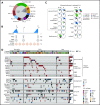Therapy-induced mutations drive the genomic landscape of relapsed acute lymphoblastic leukemia
- PMID: 31697823
- PMCID: PMC6940198
- DOI: 10.1182/blood.2019002220
Therapy-induced mutations drive the genomic landscape of relapsed acute lymphoblastic leukemia
Abstract
To study the mechanisms of relapse in acute lymphoblastic leukemia (ALL), we performed whole-genome sequencing of 103 diagnosis-relapse-germline trios and ultra-deep sequencing of 208 serial samples in 16 patients. Relapse-specific somatic alterations were enriched in 12 genes (NR3C1, NR3C2, TP53, NT5C2, FPGS, CREBBP, MSH2, MSH6, PMS2, WHSC1, PRPS1, and PRPS2) involved in drug response. Their prevalence was 17% in very early relapse (<9 months from diagnosis), 65% in early relapse (9-36 months), and 32% in late relapse (>36 months) groups. Convergent evolution, in which multiple subclones harbor mutations in the same drug resistance gene, was observed in 6 relapses and confirmed by single-cell sequencing in 1 case. Mathematical modeling and mutational signature analysis indicated that early relapse resistance acquisition was frequently a 2-step process in which a persistent clone survived initial therapy and later acquired bona fide resistance mutations during therapy. In contrast, very early relapses arose from preexisting resistant clone(s). Two novel relapse-specific mutational signatures, one of which was caused by thiopurine treatment based on in vitro drug exposure experiments, were identified in early and late relapses but were absent from 2540 pan-cancer diagnosis samples and 129 non-ALL relapses. The novel signatures were detected in 27% of relapsed ALLs and were responsible for 46% of acquired resistance mutations in NT5C2, PRPS1, NR3C1, and TP53. These results suggest that chemotherapy-induced drug resistance mutations facilitate a subset of pediatric ALL relapses.
© 2020 by The American Society of Hematology.
Conflict of interest statement
Conflict-of-interest disclosure: B.J.R. is a consultant at and has ownership interest in (including stock and patents) Medley Genomics. H.S. and L.S. are employees of WuXi NextCODE Co., Ltd. The remaining authors declare no competing financial interests.
Figures








Comment in
-
Chemotherapy at the wheel of ALL relapse.Blood. 2020 Jan 2;135(1):4-5. doi: 10.1182/blood.2019003870. Blood. 2020. PMID: 31895951 No abstract available.
-
Preexisting or therapy-induced mutations in relapsed acute lymphoblastic leukemia?Blood. 2020 Nov 5;136(19):2233-2235. doi: 10.1182/blood.2020005258. Blood. 2020. PMID: 32603411 No abstract available.
-
Therapy-induced mutagenesis in relapsed ALL is supported by mutational signature analysis.Blood. 2020 Nov 5;136(19):2235-2237. doi: 10.1182/blood.2020008107. Blood. 2020. PMID: 32688387 Free PMC article. No abstract available.
References
-
- Bhojwani D, Pui CH. Relapsed childhood acute lymphoblastic leukaemia. Lancet Oncol. 2013;14(6):e205-e217. - PubMed
Publication types
MeSH terms
Substances
Grants and funding
LinkOut - more resources
Full Text Sources
Other Literature Sources
Medical
Research Materials
Miscellaneous

